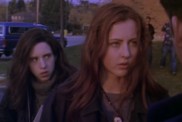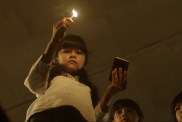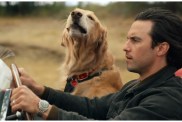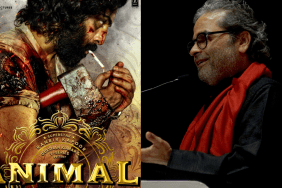The new movie from the Monsters, Inc. director (working with Bob Peterson) follows 76-year-old widower Carl Fredricksen, gruffly voiced by Ed Asner, who decides to follow his life-long dream and go on a late-life adventure to the wilds of South America. Attaching thousands of helium balloons to his house, Carl takes off, unwittingly bringing along a young stowaway in the talkative Wilderness Explorer Russell (Jordon Nagai). Once they arrive there, the unlikely duo need to work together to survive everything the jungle throws at them.
We first encountered Pete and his producer Jonas Rivera (left in photo) back at New York Comic-Con, where they previewed the first 45 minutes of the movie, doing the same a couple weeks later at Wonder-Con, where we had a chance to sit down with them for a full interview. A few weeks after that, Pete was at ShoWest to show the same 45 minutes of footage, this time in 3D. When you add the Cannes Film Festival to that impressive promotional tour, it shows Pixar Animation doing things a little differently than we’ve seen before, and we were glad to be along for the ride.
So first, we have an interview with Pete Docter and Jonas Rivera done at Wonder-Con before we had a chance to see the full movie, then we have a far more recent interview with Docter.
ComingSoon.net: Pete, you’re part of what they call the Pixar “brain trust” and there have been a bunch of movies that came out of the original idea meetings like “Cars” and “Finding Nemo.” This wasn’t one of them, so was this an idea you came up with sometime in the last couple years?
Pete Docter: Yeah, it was developed by myself and Bob Peterson. We just sat in a room and we had this great opportunity to escape the rest of Pixar and just cook up ideas. This was born out of that thought of – I don’t know about you but by the end of the day, a lot of times I’ve just had way too much of people and social situations, and I just want to escape. So this idea, this icon of a house floating off into the sky just felt like, “Ahhhhh… that feels intriguing” so we started thinking more about characters we wanted to play with. Bob and I have always loved the George Booth cartoons in “The New Yorker.” He’s this great grouchy old man, and there are plenty of other examples of great old man characters, and it was just something we felt sympathetic to, and started playing around with. Then we thought, “Maybe the old man is in the floating house and how did he get there and what led up to this and where’s he going?” and all that sort of thing.
CS: That’s such a striking visual, the house with the helium balloons. I could see an artist just sitting there drawing something like that and then trying to tell a story around it.
Docter: Yeah, exactly.
Jonas Rivera: Some of the concept art from those days was really fun. You had done that one drawing of just an old guy with the balloons and that was the birth of the movie.
Docter: Yeah, grouchy guy with this really grrrr… sour face with all these (voice quickly accelerates and rises in pitch) happy, fun, colorful balloons! The juxtaposition of that seemed funny, too.
CS: Jonas, when did you get involved? You had been at Pixar for a while.
Rivera: Yeah, you guys were probably in development on this for about a year, maybe more, and I came on to produce once it had enough traction to start putting together the story reels and building our screenings and getting it going. My job was to plug into what they had done and try to figure out how to get it done, which is always interesting when you hear the first pitch and you see the story reels. In my opinion, it’s the purest way you’d ever see it. I always wished in some ways we would just do vaudeville and just take Pete and Bob out on the road and tell it because it was so beautiful. But you have to get a crew, you have to get all the computer science and the staffing and the money and the casting.
Docter: One of the unknowns that needs to be solved.
Rivera: You hope that you don’t water it down, and that was my job to balance that.

CS: That’s an interesting idea. At what point did Ed Asner get cast as the voice? We haven’t seen him do much in a while and he seems perfect.
Rivera: Yeah, he’s such a great actor.
Docter: Yeah, we just looked around at all the actors we could find and he seemed to have one of the real important things, which was the comedy chops to be able to do some of these things. He’s got a real acerbic attack, the way he delivers lines and the comedy he’s added to the thing has been a lot of fun.
Rivera: He really helped strike the balance with the character of curmudgeon and charm. Too much of one or the other and you spoil it and Ed really had the precision to…
Docter: And that’s the way he is in real life, too. He’ll come into the room and bark at you, and yet he does it with a little twinkle that you know he doesn’t really hate us, he’s just telling us that he does. (laughs)
Rivera: When he came into read for the character, we had the sculpture on the table, and I’ll never forget what he said. “I don’t even look like that guy!” “Well, alright, do you not want to do it?” “No, I want to do it.”
CS: How did you find Jordan to voice Russell?
Rivera: That was a lot of work actually. We went to all the casting directors we knew in New York and Los Angeles and Chicago, and what we found was that we were getting a lot of great actors, but they didn’t really fit the suit, so to speak, it was almost too actorly, and what this kid really needed was this authenticity. I think it was actually Jordan’s brother who had come in to read, who was an actor, had done some commercials…
Docter: They put up flyers in churches and community centers and all sorts of stuff trying to get kids. “Interested in acting? Come down and read!”
Rivera: Yeah, and his little brother just started talking about his soccer practice and doing karate lessons and stuff and Bob and I said, “This is great” and we put him on the mic, and he ended up sounding exactly like what we thought Russell would be, just chirping away at Carl.
Docter: I don’t even remember what he was saying, but I just remember laughing at the sound of his voice and thought, “Well, that’s a good sign.”
CS: I was wondering how you auditioned for the role, whether you actually wrote out lines for them to read, etc.
Rivera: We did write lines but he just kind of fell right off of them. Then we tried it with the lines and we thought we could make it work.
Docter: The process of directing kids I had done before. It’s a lot of trickery and a lot of game-playing, especially with Jordan. He’s such a smart kid, he would very quickly get bored with what we were asking him to do, so you’d have to find other ways of making it interesting. “Okay, this time, before you say the line, I want you to run down to that end of the room, run around the fussball table three times, come back here, jump up and down and say the line.” So he would do that and he’d be like, “What? How many times? Three times?” So you kind of find ways of tricking him and making it interesting.
CS: How old is he?
Docter: He was 7 at the time we started…
Rivera: (without missing a beat) Yeah, he’s 25 now. (laughter)

CS: Why was it important to have Russell be an Asian kid? Was it just to add some variety or have something different?
Docter: Initially, we thought, “Well, let’s do something new that we haven’t seen before and be as specific as we can.” We patterned him largely off this guy at work, Pete Sohn, who is incredibly entertaining.
Rivera: Have you met Pete? He did the voice of Emil, the fat hungry brother in “Ratatouille.”
Docter: But he’s also an amazing artist, an amazing animator, one of these guys you hate because he can do everything incredibly well, but he’s so appealing and wonderful that you can’t hate him. We love him and the character of Russell kind of grew out of his attention deficit order kind of thing. He’s great because you show him stuff and he can’t help himself. He has to tell you the truth. Most people are a little more guarded, they’re like, “Oh, great, that’s wonderful. I like this or that, this didn’t work for me.” Pete just like “WOAAAAAH!” he just immediately reacts.
Rivera: He’ll yell and scream and he’ll tuck his shirt in, he might spill his coffee, but he’s brilliant…
CS: Did he work on the movie at all?
Docter: He did some of the first scenes on the film.
Rivera: He storyboarded the house going up. He’s brilliant, so it’s patterned after him a bit.
Docter: He designed some of the first drawings on that character.
CS: Is there room for improv on something like this? Ed Asner is probably really good at that so do you do a lot of that during the recording sessions and have them try different things?
Docter: We do, we do. A lot of it, of course, is that we want to create the myth of spontaneity as much as we can. These films take five years to make and yet what you’re hoping is that the audience will watch it and feel like it’s happening right there magically in front of them. So improvisation is a good way to make that feel right, although a lot of times we’ll end up writing a bunch of stuff down, we’ll do some improv and then use that to drive the line that we had written. There’s all sorts of story reasons why he has to say these words, although once in a while we’ll change those, too.
Rivera: It’s harder for them to improv, too, because they’re usually never with the other actor. Ed is such a great TV actor of course and they work as a group, and it’s a lot harder standing at a table with a mic.
Docter: In a grey room…
Rivera: Exactly, but he would certainly come up with some ideas and riff on things.
CS: It’s funny because Pixar doesn’t go for the Jack Blacks or those comedy guys who can just come up with lots of great stuff through improvisation.
Docter: Yeah, well it’s all depending on the character. Like Billy Crystal is really genius with improv and he chimed in with tons of stuff, then you have to go back and say, “Which of these great ideas… we can only use one so which should it be?”
Rivera: Owen Wilson did that on “Cars” – he’d take it a different way, and it was really great.
CS: In the first 45 minutes, we’ve seen a lot of set-up, but is there actually an overall villain we’ll see besides the dogs?
Rivera: There’s a lot coming.
Docter: There are other things you don’t know about. From the beginning, the film was designed to have these three parts to it. This weighty emotion to it, the comedy and then the action, and the action is mostly stuff you haven’t seen yet. Hopefully all of that is woven in to some degree. You feel it at the beginning, it’s all set-up, but the real action stuff comes later, so you haven’t seen much of that yet.
Rivera: We’re saving that.
CS: Can you talk about getting Michael Giacchino to do the music?
Rivera: He just fit so well into this film that we were just thrilled to have him, he’s amazing. It’s one of the coolest parts.

CS: You’ve done so much animation over the years, so have you ever had any inclination to do live action films? We’ve seen a lot of really good animation directors like Andrew Adamson go back and forth. Have you thought about that at all?
Docter: Well, for me personally, I’m more intrigued by the illusion of animation and the knowledge that this is crafted frame by frame. It’s all kind of like a magic trick and I really love magic as well, and knowing how the trick works. When you see a really good magician, you go, “I know how he did that but I still don’t know how that works.” You’re fooled anyway, and to me, there’s something about animation that on the one hand, you know it’s completely crafted and fake, and yet when it’s done well, you can cry and laugh and you’re totally drawn into it and that’s the intrigue of it for me.
CS: When you were in New York last month, you were asked about “Monsters, Inc. 2” and then last week, there was all this talk about it, so we thought you must have been inspired by all the questions.
Docter: I think somebody just took something I said and interpreted it in some way. So far, it’s like everything else. If we come up with a great story that we feel needs to be told then we’ll do it.
CS: Maybe it’s just wishful thinking because everyone wants to see John Goodman and Billy Crystal back together.
Rivera: Maybe.
Docter: That’s a good problem to have.
Now here’s a follow-up interview with Docter done very recently–earlier today, in fact:
CS: I saw the preview at New York Comic-Con three and a half months ago, so it’s been quite a journey for this movie since then. Does it feel like there’s a very different tone or energy towards the movie than “Monsters, Inc.” or other Pixar movies since then?
Docter: Oh, yeah. I think for whatever reason, people seem very surprised by this film. It partly might be our choice too, as we’re putting the word out in advertisements and what not, we’re emphasizing the comedy and the action, which I’m really proud of and it doesn’t misrepresent the film or anything, but I think people are surprised by the emotion and the other elements that are there in the story. That’s really cool, I think, that you go in for one thing and you get more. John (Lasseter) is always talking about over-delivering in the stuff we do, and that’s really cool.
CS: Where has Bob been during all of this? I was kind of surprised we haven’t seen much of him. Has he just been holding down the fort on finishing the movie during this time?
Docter: Bob, well right now he’s working on a film that will be out before you know it, so he’s got a lot of work on his hands. The last year of production I guess, he transitioned off onto development, to work on his own thing, so yeah, he’s been busy.
CS: You’ve probably been spending three or four years on this movie yourself, so do you deal with a lot of the other Pixar stuff going on in that time as well or are you able to just focus on this?
Docter: Pretty much exclusively on this. Once in a while, we’re at these meetings where we all look at “Toy Story 3” or “Brave” or whatever and we all give comments and notes, but that’s just like a day here or there.
CS: How was Cannes? The last time I spoke with you and Jonas, I don’t think that was even announced, so that was a surprise. How was it received? Did you have a lot of snooty French critics wearing tuxes and 3D glasses?
Docter: Yeah, yeah, it was a surprise. We had no idea what to expect. You go over there and I’d never been. I was warned that audiences can be rather harsh; if they don’t like something, they “boo” it, so that was a little bit nerve-wracking, but it ended up really well. We screened the film and everybody was there in their 3D glasses and tuxedoes, and that was quite a sight, and then at the end, when the lights came up, we got a standing ovation. Of course, you’ve probably seen a lot of the reviews are glowing and very positive.

CS: On every Pixar movie, there seems to be one breakthrough in animation in terms of something no one else has tried before. What ended up being the biggest challenge you had to get past to make this come to life?
Docter: Yeah, it’s funny. I will say the biggest technical challenge was an artistic one. The level of caricature that we had on this film, there are cheats all over the place, and hopefully you don’t notice any of it. It’s all kind of been minimal, but an example being the balloons. We have distance shots and wide shots on the house floating with balloons, and if we showed the balloons at normal scale, they almost just look like noise, like static, so we scaled them up to be… in some shots, if you really scrutinize them–eyeball the balloon and then look down at the house–they’re bigger than the front door, they’re huge! Because they’re visually separated, you totally buy it and it’s exactly what you need. Then in the next shot, when the balloon is drifting down past a window or by a character, you have to shrink it down, so there’s a lot of it. That’s just one example of many different scale cheats we had to do. Then things like cloth, simplifying the folds and wrinkles in Carl’s jacket or Russell’s shirt, just trying to get that sense of simplicity was oddly very difficult.
CS: What about the actual physics of having a house being carried by balloons? There has to be a bit of suspension of disbelief about it, so did you guys spend a lot of time figuring out how this might be possible or did you just go with it and hope no one called you on it?
Docter: It’s definitely a balance. What’s funny is that you do a drawing of a house being lifted by a balloon, you can get away with a lot, and then the more you approach reality, the more detailed shading and lighting and things you put in, the more it starts to really demand more realism. Part of that was why we decided to do the level of caricature that is in the film, because we knew that there was a floating house and if you try to film that in real life, you’d need an obscene amount of balloons. In fact, one of the guys that worked with the simulation of the balloons calculated it would take approximately 26.5 million balloons to lift a real house of that size. We definitely knew we were cheating but what we did was just to try… I came up with this idea of visually referencing a hot air balloon to basket ratio. We’ve all seen hot air balloons and we know that basic ratio, so we tried to mimic that with the clump of balloons vs. the house. That seemed to be enough for people to buy into it, and we’ve never gotten any audience member thrown by that, bizarrely, which is good because that’s the central theme of the movie.
CS: How did 3D play into all of that, because it’s obviously not as forgiving? You knew as you were making it that it would screened and viewed in 3D, so did you have to monitor that constantly to see how it was playing?
Docter: Yeah, 3D is a really tricky thing because on the one hand, it’s Pixar’s first 3D movie and on the other, I knew that the majority of viewings of it, especially when it gets to home video, would likely be 2D, so we really tried to make it work in both. You don’t compromise anything in one version or another. We tried to use 3D both subtly – more subtly than has been done in the past where we’re really not showcasing 3D as much as using 3D emotionally to tell the story. So we’re not sticking stuff in your face and being showy about it. It’s there for emotional effect like if Carl is alone in his house, we really made it flat vs. a scene, for example, of him floating in his house where we tried to emphasize the depth, so you just use for emotional effect.
CS: When you were making this, you didn’t have a lot of 3D movies to reference, so was it really just a feel thing or instinct?
Docter: When John came to us and asked us to do it 3D, we started by looking at as many 3D movies as we could like “Dial M for Murder.” They go back a number of years. There was even a “Three Stooges”–I forgot the name, which one it is–but a bunch of movies in 3D and of course, some more modern ones as well. Whenever you get the sense the filmmaker is first and foremost is saying, “This is a 3D movie!!” as opposed to “This is a story about fill-in-the-blank that happens to be in 3D,” I think that’s where it gets in the way and it becomes a stumbling block to good storytelling.
CS: Having worked in 3D, have you thought or been approached about redoing “Monsters, Inc.” in 3D? I know the “Toy Story” movies are being done, so has that come up yet?
Docter: No, it hasn’t, and I don’t know. I can’t say never would it happen or not. I guess we’ll just approach that as we go forward and continue to see how popular the reissues of “Toy Story 1 and 2” are.
Up opens in Disney 3D and in conventional 2D on Friday, May 29.









